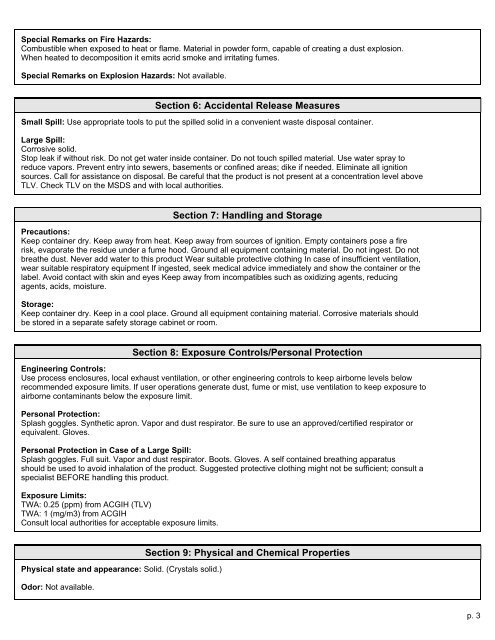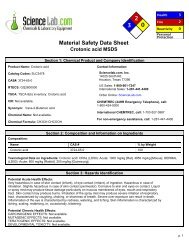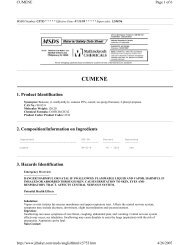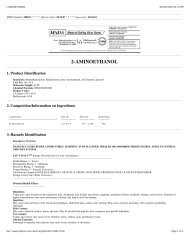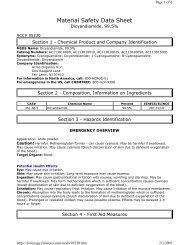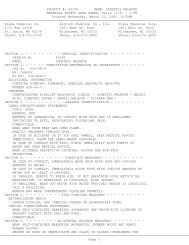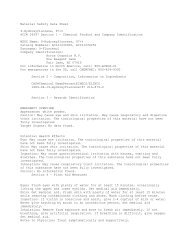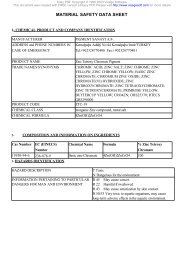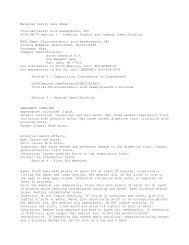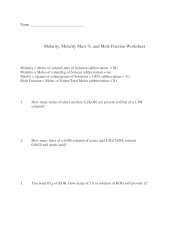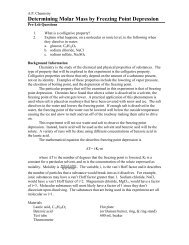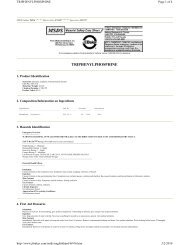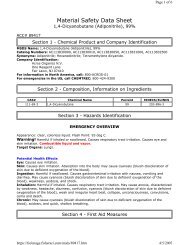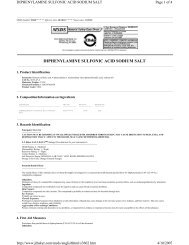Create successful ePaper yourself
Turn your PDF publications into a flip-book with our unique Google optimized e-Paper software.
Special Remarks on Fire Hazards:<br />
Combustible when exposed to heat or flame. Material in powder form, capable of creating a dust explosion.<br />
When heated to decomposition it emits acrid smoke and irritating fumes.<br />
Special Remarks on Explosion Hazards: Not available.<br />
Section 6: Accidental Release Measures<br />
Small Spill: Use appropriate tools to put the spilled solid in a convenient waste disposal container.<br />
Large Spill:<br />
Corrosive solid.<br />
Stop leak if without risk. Do not get water inside container. Do not touch spilled material. Use water spray to<br />
reduce vapors. Prevent entry into sewers, basements or confined areas; dike if needed. Eliminate all ignition<br />
sources. Call for assistance on disposal. Be careful that the product is not present at a concentration level above<br />
TLV. Check TLV on the MSDS and with local authorities.<br />
Section 7: Handling and Storage<br />
Precautions:<br />
Keep container dry. Keep away from heat. Keep away from sources of ignition. Empty containers pose a fire<br />
risk, evaporate the residue under a fume hood. Ground all equipment containing material. Do not ingest. Do not<br />
breathe dust. Never add water to this product Wear suitable protective clothing In case of insufficient ventilation,<br />
wear suitable respiratory equipment If ingested, seek medical advice immediately and show the container or the<br />
label. Avoid contact with skin and eyes Keep away from incompatibles such as oxidizing agents, reducing<br />
agents, acids, moisture.<br />
Storage:<br />
Keep container dry. Keep in a cool place. Ground all equipment containing material. Corrosive materials should<br />
be stored in a separate safety storage cabinet or room.<br />
Section 8: Exposure Controls/Personal Protection<br />
Engineering Controls:<br />
Use process enclosures, local exhaust ventilation, or other engineering controls to keep airborne levels below<br />
recommended exposure limits. If user operations generate dust, fume or mist, use ventilation to keep exposure to<br />
airborne contaminants below the exposure limit.<br />
Personal Protection:<br />
Splash goggles. Synthetic apron. Vapor and dust respirator. Be sure to use an approved/certified respirator or<br />
equivalent. Gloves.<br />
Personal Protection in Case of a Large Spill:<br />
Splash goggles. Full suit. Vapor and dust respirator. Boots. Gloves. A self contained breathing apparatus<br />
should be used to avoid inhalation of the product. Suggested protective clothing might not be sufficient; consult a<br />
specialist BEFORE handling this product.<br />
Exposure Limits:<br />
TWA: 0.25 (ppm) from ACGIH (TLV)<br />
TWA: 1 (mg/m3) from ACGIH<br />
Consult local authorities for acceptable exposure limits.<br />
Physical state and appearance: Solid. (Crystals solid.)<br />
Odor: Not available.<br />
Section 9: Physical and Chemical Properties<br />
p. 3


